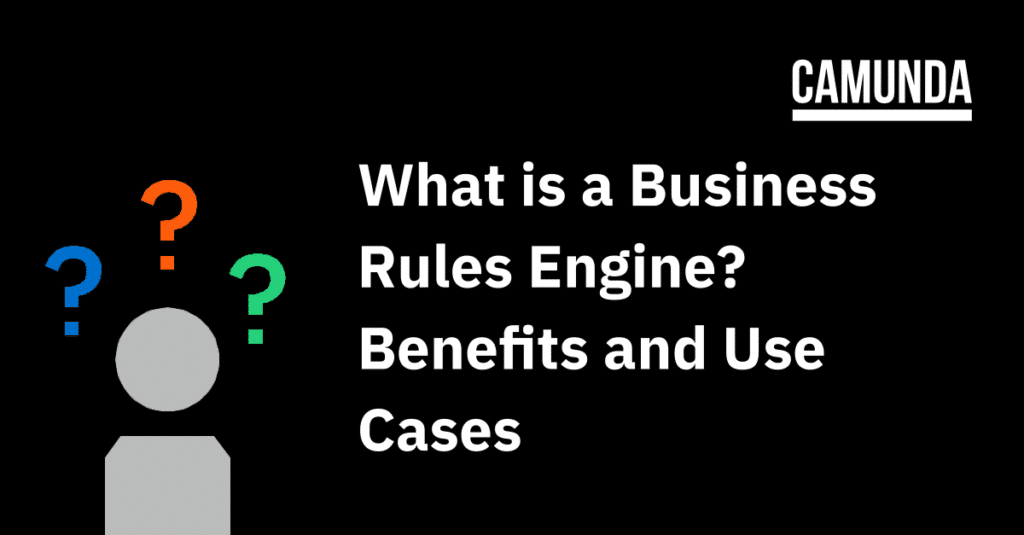Policies or standard operating procedures with predefined rules that dictate how your business operations should be conducted are important in every business. When implementing process orchestration, it is important to streamline your processes by automating decision-making within those processes.
This can be done by implementing a business process rules engine that provides the following functionality:
- Define business rules
- Manage these rules
- Execute the rules
What makes up a business rules engine?
When selecting a workflow rules engine, you want to ensure that it has all the necessary components to meet your requirements and will grow with your business in the future. Let’s look at some of these features and functions that should be part of any business process rules engine.
Business rules definition and management
You need a business rules engine that can provide specific conditions and guidelines that will govern how your business processes (and rules) will be executed in that process. These rules may be related to discount offerings, risk assessment, pricing rules, compliance, and more.
You also must have the ability for authors and business analysts to define these rules using an interface that is easy to understand without the need for deep programming knowledge.
Business rule automation and execution
A workflow rules engine will automatically apply business-defined rules to make decisions within your business processes. A good example is determining if a customer meets some criteria to qualify for an insurance policy by checking their driving record and other pertinent information.
It is not uncommon for the rules engine to integrate with other business systems, including other workflows, to ensure that all rules are consistently applied and followed.
Flexibility and agility
To stay competitive today, your business must be agile and quickly adaptable to changes in the marketplace, business strategies, and regulations—this means your rules engine must be equipped to adapt to these changes. You must be able to update rules without having to alter the underlying application code.
Business decisions are subject to constant change as organizational needs evolve and regulations and procedures change—automating decisions helps you quickly adapt.
Your business rules engine needs to process large volumes of complex decision logic and scale to meet those volume needs while allowing you to make changes quickly.
What are the benefits of a business process rules engine?
Significant benefits result from securing and implementing a strong, flexible, and adaptable business rules engine. These include:
- Efficiency. With a workflow rules engine, you can easily and automatically handle repetitive decision-making tasks allowing staff to take on more strategic activities.
- Consistency. Business decisions can be made consistently and according to defined rules when you have a business process rules engine.
- Compliance. A business process rules engine helps in maintaining compliance with regulatory requirements by consistently applying the necessary rules and checks.
- Transparency. Crucial for compliance and analysis, business process rules engines provide a clear and auditable trail of what and how decisions are made.
Zeebe—an example of a strong business rules engine
Zeebe is the workflow and decision engine that powers Camunda. Its cloud-native design provides what you need to future-proof your process orchestration: performance, resilience, and security. Zeebe automates and executes decisions using decision modeling notation (DMN), a global standard for decision modeling and automation. Zeebe executes DMN models at scale, allowing both non-technical and technical stakeholders to collaborate on business rules design using a widely-used modeling language.
With DMN, you can align your business needs with technical implementation and reuse decision logic across different processes, shortening development cycles and rolling out automated decisions faster.
With Zeebe’s DMN decision engine, businesses can automate decisions and orchestrate them as part of end-to-end business processes. Not only can you collaborate across business lines and IT to build your decision rules, but you can also reuse this logic leveraging efficiencies across the organization. With Camunda you can build business decision automation with minimal disruption thanks to a standards-based, developer-friendly integration approach.
DRD and DMN
With Camunda’s decision engine, customers can define decision requirements diagrams (DRDs) that detail the inputs to making a decision. In the example below, a decision is required to determine the risk associated with an applicant for a loan. As input to this decision, there are five items:
- Requested loan amount
- Credit score
- Annual salary
- Debt-to-income ratio
- Liquid assets

The Determine Risk component in the above diagram represents the decision table below, which is used to make the risk decision.

Using the inputs (for example, a deficient credit score or an average score with a low debt-to-income ratio and a smaller loan), the decision table will return the appropriate risk level for the applicant.
This can now be used in a business process to determine the next steps as indicated below.


By linking the proper decision table to the workflow element, you are automating the decision process and then can use the output information to determine the next steps.
Note: This example is not intended to be a full risk assessment decision table and is for example purposes only.
Use cases for business rules engines
You might be wondering where business rules engines are used and in what businesses, so here are a few examples:
- In healthcare, business rules engines help with insurance claim processing and eligibility verification.
- Business rules can be used to automate aspects of claims processing and also to help with risk assessment in property and casualty insurance.
- Automating credit scoring, compliance check and fraud detection can also be accomplished with business process rules engines in financial services.
- In manufacturing, rules engines can automate customer service inquiries, inventory management, and help with dynamic pricing.
- Implementing a business process rules engine in telecommunications can automate service provisioning, billing rules, and customer segmentation.
Stay agile and flexible
A business process rules engine helps organizations streamline and optimize decision-making within their processes which enhances agility, compliance, and operational efficiency.
Read more about business rules and how they can be used
Camunda has several additional blogs that discuss the use of our business process rules engine in various use cases. Take a look to obtain more helpful information:
- Decision Engines: What They Are and What They Do
- How Decision Modeling and AI Help with Risk Assessment
Learn more about DMN and its role in BPMN, and don’t forget to try our DMN simulator.



Start the discussion at forum.camunda.io